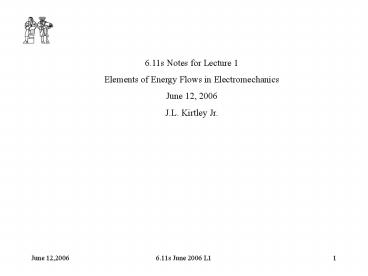6.11s Notes for Lecture 1 PowerPoint PPT Presentation
Title: 6.11s Notes for Lecture 1
1
6.11s Notes for Lecture 1 Elements of Energy
Flows in Electromechanics June 12, 2006 J.L.
Kirtley Jr.
2
Take this as a prototypical machine form
3
(No Transcript)
4
(No Transcript)
5
(No Transcript)
6
(No Transcript)
7
Field Description of Forces Maxwell Stress Tensor
If we include forces due to changing
permeability, We find force is the divergence of
something we call a Tensor
8
Force on an object is the integral of force
density
9
Forces due to fields normal to a surface Assume
these are highly permeable poles
Force is UP on lower pole, DOWN on upper pole
10
(No Transcript)
11
Poyntings Energy Flow is
Power flow INTO a volume is
This means we must invoke our old friends,
Faradys Law and Amperes Law
12
(No Transcript)
13
(No Transcript)
14
Using the two induction equations, we find
Of course J is flowing in something, and if that
is stationary
15
If the magnetic material is linear and lossless,
the magnetic term is clearly rate of change of
energy stored. More on this later
If the material is moving,
And this last is clearly energy conversion
(velocity times force density)
16
Now look at a prototypical situation like an
air-gap. We are looking in the axial direction
and there is no variation tha way. Excitation is
z-directed and like a traveling wave
Since Faradays Law is
The interesting part of this is
17
Now suppose the lower surface is moving
Now energy flows are related In the stationary
frame
And in the moving frame
The difference between these must be energy
converted
18
Now consider about any type of system with
voltage and current defined at a pair of
terminals Energy into those terminals over a
time interval is And over a periodic cycle,
energy input per cycle is Here we would have
net energy IN to the system (possibly a motor?)
19
If there is no motion so there are no mechanical
terminals, we have an analysis of hysteretic
material loss There is more to this than fits on
a page -- see the notes
20
Here is a simple cartoon model of a linear
induction motor. The analysis follows steps we
have already outlined
21
Surface Impedance is important For energy flow,
For a layer of magnetically linear conductive
stuff excited by a traveling wave
In iron, if we can idealize the saturation curve,
22
Iron Loss Consists of Eddy Current
(linear) Hysteresis (nonlinear and hard to
characterize) Semi-Empirical Curve Fit

